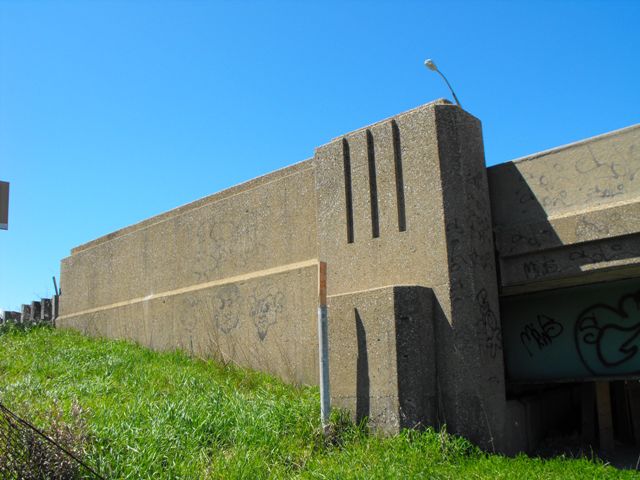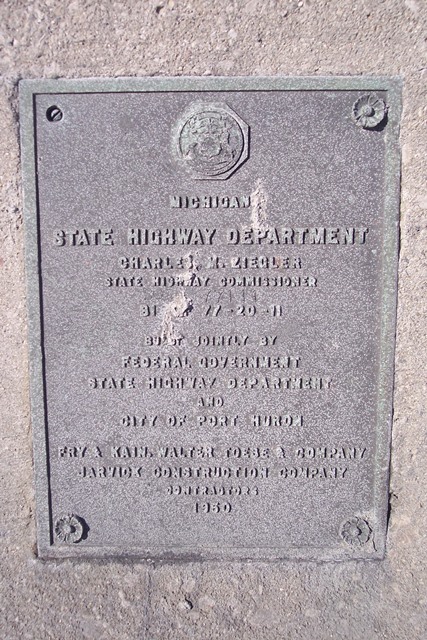We Recommend:
Bach Steel - Experts at historic truss bridge restoration.
BridgeHunter.com Phase 1 is released to the public! - Visit Now
I-94 / I-69 Black River Bridge

Primary Photographer(s): Nathan Holth
Bridge Documented: July 11, 2003, July 6, 2007, April 23, 2010, and November 22, 2011
Port Huron: St. Clair County, Michigan: United States
Metal Variable Depth Deck Girder, Fixed and Approach Spans: Metal Stringer (Multi-Beam), Fixed
1950 By Builder/Contractor: Fry and Cain / Walter Toebe Company and Engineer/Design: Michigan State Highway Department
Not Available or Not Applicable
146.0 Feet (44.5 Meters)
766.0 Feet (233.5 Meters)
56.8 Feet (17.31 Meters)
3 Main Span(s) and 7 Approach Span(s)
77177111000B030

View Information About HSR Ratings
Bridge Documentation
This bridge no longer exists!
Bridge Status: Demolished and replaced ca. 2011.View Archived National Bridge Inventory Report - Has Additional Details and Evaluation
View Historical Articles About This Bridge
View Some Original Plan Sheets For This Bridge
Although not the most beautiful bridge in the world at the time of demolition, this bridge was a noteworthy bridge that although on I-69/I-94, actually pre-dates the Interstate Highway System, and has some technologically significant details. This bridge was built in 1950, and was originally part of M-146, a short trunkline road that was long ago decommissioned. M-146 was a short route that ran from 24th Street, to Lapeer Avenue, then to what is today M-25. When built, this bridge would have looked a lot more beautiful, because it had Michigan's signature type R4 railings like those seen on Sigler Road. These attractive railings would have complimented the modest architectural detailing on the piers and abutments of this bridge. The architectural details of the piers and abutments managed to survive on the bridge, but the R4 railings were replaced with New Jersey barriers, which greatly diminished the aesthetic value of the bridge.
Structurally, the bridge consists of three deck plate girder spans and seven steel stringer spans. The bridge was technologically significant for its uncommon cantilevered deck plate girder design which includes an 86 foot suspended span which is connected to the bridge by a pin and hanger type system. The Michigan State Highway department built a number of cantilevered deck plate girders across the state, and a number of them remain today. Not all of them have the pin and hanger detail however. The anchor arm main spans on either side of the cantilever span include a field splice connection where the built-up plate girders were attached during erection. Also, the bridge was designed so that the main spans of the bridge function at two separate parallel bridges sharing a single pier. There are two pairs of deck plate girders under the bridge, each with their own set of floorbeams. At certain locations under the bridge a tiny gap in the deck is visible demonstrating this two bridge design. Finally, adding to the complexity of this bridge was the seven approach spans which turn the bridge into a relatively long (for Michigan) bridge of 766 feet. Also, the bridge had an 18 degree skew.
Unfortunately, this bridge ended up being sentenced to the dumpster. As a 1950 bridge that was not designed with the Interstate Highway System in mind, the bridge was very narrow and a serious bottleneck for expressway traffic, lacking an acceleration lane for the Water Street ramp, and also lacking sufficient shoulders. Structurally however, the bridge was still in decent condition. The steel superstructure appeared to be in very good condition, with the only areas of significant rust and deterioration being around expansion joints. The abutments and piers had some areas of spalling, but nothing severe that could not be corrected by rehabilitation. The deck was the only part of the bridge in extremely bad condition. One could not complain too much about the deck however, since it appeared to be the original 1950 deck, which is impressive given the massive volume of heavy truck traffic this bridge has carried as an I-69/I-94 bridge. The replacement of this bridge was part of a larger project to completely reconstruct I-69/I-94 in the immediate area, and this greater project was designed to compliment a planned expansion of the toll and customs plaza for the Blue Water Bridge.
As the ad shown below indicated, steel for this bridge was fabricated locally under subcontract by F. Yeager Bridge and Culvert Company of Port Huron.
This bridge is tagged with the following special condition(s): Unorganized Photos
![]()
Photo Galleries and Videos: I-94 / I-69 Black River Bridge
Structure Overview
Original / Full Size PhotosA collection of overview photos that show the bridge as a whole and general areas of the bridge. This gallery offers photos in the highest available resolution and file size in a touch-friendly popup viewer.
Alternatively, Browse Without Using Viewer
![]()
Structure Details
Original / Full Size PhotosA collection of detail photos that document the parts, construction, and condition of the bridge. This gallery offers photos in the highest available resolution and file size in a touch-friendly popup viewer.
Alternatively, Browse Without Using Viewer
![]()
Structure Overview
Mobile Optimized PhotosA collection of overview photos that show the bridge as a whole and general areas of the bridge. This gallery features data-friendly, fast-loading photos in a touch-friendly popup viewer.
Alternatively, Browse Without Using Viewer
![]()
Structure Details
Mobile Optimized PhotosA collection of detail photos that document the parts, construction, and condition of the bridge. This gallery features data-friendly, fast-loading photos in a touch-friendly popup viewer.
Alternatively, Browse Without Using Viewer
![]()
Additional Unorganized Photos
Original / Full Size PhotosA supplemental collection of photos that are from additional visit(s) to the bridge and have not been organized or captioned. This gallery offers photos in the highest available resolution and file size in a touch-friendly popup viewer.
Alternatively, Browse Without Using Viewer
![]()
Additional Unorganized Photos
Mobile Optimized PhotosA supplemental collection of photos that are from additional visit(s) to the bridge and have not been organized or captioned. This gallery features data-friendly, fast-loading photos in a touch-friendly popup viewer.
Alternatively, Browse Without Using Viewer
![]()
Maps and Links: I-94 / I-69 Black River Bridge
This historic bridge has been demolished. This map is shown for reference purposes only.
Coordinates (Latitude, Longitude):
Search For Additional Bridge Listings:
Bridgehunter.com: View listed bridges within 0.5 miles (0.8 kilometers) of this bridge.
Bridgehunter.com: View listed bridges within 10 miles (16 kilometers) of this bridge.
Additional Maps:
Google Streetview (If Available)
GeoHack (Additional Links and Coordinates)
Apple Maps (Via DuckDuckGo Search)
Apple Maps (Apple devices only)
Android: Open Location In Your Map or GPS App
Flickr Gallery (Find Nearby Photos)
Wikimedia Commons (Find Nearby Photos)
Directions Via Sygic For Android
Directions Via Sygic For iOS and Android Dolphin Browser
USGS National Map (United States Only)
Historical USGS Topo Maps (United States Only)
Historic Aerials (United States Only)
CalTopo Maps (United States Only)






